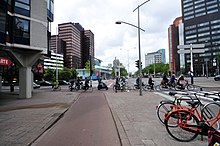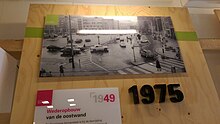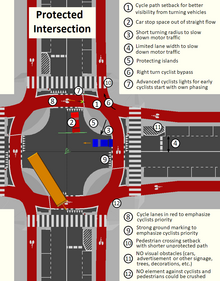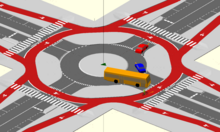Protected intersection
A protected intersection is an at-grade road junction in which cyclists and pedestrians are separated from cars. Vehicles turning right (in countries driving on the right, or left in countries driving on the left) are separated from crossing cyclists and pedestrians by a buffer, providing increased reaction times and visibility. Drivers looking to turn right have better visibility of cyclists and pedestrians as they can look to the side for conflicts instead of over their shoulders. At unsignalized intersections, it is practice to have one car length of space between the cycleway and roadway, so that cars exiting the minor street have an area to pull forward and wait for a gap in traffic, without becoming distracted by potential simultaneous conflicts along the cyclepath.

This type of intersection has for decades been used in the bike-friendly Netherlands, and Denmark. It is also one of the main ways cyclists are transported across intersections in central European countries, and in outlying suburban areas in China[citation needed]. An alternative philosophy, design for vehicular cycling, encourages having bike lanes simply disappear, or "drop", at intersections, forcing riders to merge into traffic like a vehicle operator ahead of the intersection in order to avoid the risk of a right-hook collision, when a right turning motorist collides with a through moving cyclist. Design policies which do not allow the cyclist to remain separated through the intersection have come under increasing scrutiny in recent years as not being inclusive to riders of all abilities,[1] leading to lower overall ridership and sidewalk riding,[2][3] and being less safe.[4]
Other countries and jurisdictions where they were not previously common are beginning to install, and/or incorporate into standard details, protected intersections with varying degrees of similarity to those in the Netherlands,[5] including the UK city of Manchester,[6] Australian city of Melbourne,[7] over two dozen U.S. locations,[8] including in Austin,[9] Boston,[10] Chicago,[11] Davis, Pittsburgh,[12] Salt Lake City,[13] San Diego,[14] Seattle,[15] Silver Spring,[16] Jersey City,[17][18] and Canadian cities Ottawa,[19] Vancouver, and Waterloo.
History[]

With the popularity of the bicycle, the Dutch began constructing separated cycle tracks as early as the late 1800s.[20] The separation of road users into neatly defined right-of-ways may be linked to Dutch culture in general, which values cleanness and organization.[21] After World War II, the country's infrastructure was decimated, and some cities like Rotterdam had to be completely rebuilt.[22] This presented the opportunity to create infrastructure more in line with the "modern" way. From the 1940s to the 70s, streets were built following a new design philosophy that attempted to integrate cyclists with vehicle traffic.[23] After three decades, these designs proved to be largely a failure, with the number of kilometers cycled falling by 65% and the per-km rate of cyclists being killed increasing 174%.[24]
In the 1970s, road traffic and urban quality of life began to be seen as a significant issue in Dutch city politics. This, combined with other political headwinds related to party reorganization, the decline of national religious pillars, and opposition to the Vietnam War propelled left wing political parties to office in many city governments. In Groningen, a northern Dutch city with one of the highest bike mode shares, the left wing party put forth a new circulation plan which again prioritized bicycle traffic and moved away from the notion of designing for bicyclists to act like motor vehicle operators.[25] As the nation again began to desire separated bike infrastructure, the protected intersection rose to prominence as an engineering solution for optimizing sightlines. It joined other Dutch innovations in traffic calming and bike design, like the woonerf, and the bicycle street (fietsstraat), a variant of which exists in North America (see bicycle boulevard). Today, the Netherlands is widely considered the world's premier country for cycling, with more than 25% of all trips made by bike.[26] It has reported a significantly lower cyclist fatality rate following the return to separated infrastructure. In the US, 58% of bicycle crashes involving injury, and 40% of crashes involving death occurred at intersections.[27]
The protected intersection is only one of several treatments for addressing motorist-cyclist conflicts. While used in much of the Netherlands, including Amsterdam, local road authorities in other parts of the country do not use the classic protected intersection with middle islands, preferring to have cyclists move during a completely separated all directions green phase.[28] Other options for reducing bike accidents at intersections, depending on context, include the use of bridges and tunnels, and planning or reconfiguring the neighborhood street/path system so that major amenities and schools can be reached without needing to travel along busy roads.
Features[]

This protected intersection example features a number of common elements that optimize safety.
- A corner refuge island
- A setback crossing for pedestrians and cyclists, between 2–5 meters (6 - 16.5 ft) at signalized junctions
- A forward stop bar, which allows cyclists to stop for a traffic light well ahead of motor traffic who must stop behind the crosswalk, therefore placing bicycles in better view of the right turning car.
- Separate signal phases, or at least a leading green interval for cyclists and pedestrians, to give cyclists and pedestrians no conflicts or a head start over motor traffic.
- The design makes a right turn on red, and sometimes left on red depending on the geometry of the intersection in question, possible for cyclists. In many cases, the cyclist who is separated from motor traffic can turn right without even needing to come to a complete stop.[29]
Clear ground striping is key to define the cycle lane and its priority. Wide strips are painted aside the cycle way and 'shark teeth' (triangles with pointy end oriented toward the non priority vehicles) are used to reinforce who must yield. In addition to ground marking, the cycle lane color plays a role to remind motorists of cyclist priority. In the Netherlands, the cycle way red color is not painted but embedded in asphalt to increase durability and reduce costs.
Also often the cycle lane is slightly raised in the crossing, to again invite motorists to decrease speed.

Cyclists ideally have a protected bike lane on the approach to the intersection, separated by a concrete median with splay curbs if possible, and have a protected bike lane width of at least 2 meters if possible (one way). In the Netherlands, most one way cycle paths are at least 2.5 meters wide.[30]
Reduced radius could increase difficulties to turn for larger vehicles (trucks and busses), so in some cases, mountable islands have been used, similarly to the truck mountable aprons which surround the center island of roundabouts.
In terms of optimal spacing between the path and motorist lanes, it is generally practice to use 2–5 meters at signalized crossings and one car length >5m at unsignalized intersections. Providing more buffer space allows vehicles, particularly those turning out of smaller roads, to queue in the waiting area. On the other hand, larger buffers could place the cyclist at a less optimal viewing point from the mainline, and delay the signal operation due to longer distances necessitating slightly longer bicycle signal yellow and all red clearance intervals. The exact optimal distance has been the subject of several studies.[31][32]

Protected roundabouts[]
Protected roundabouts are a variation of protected intersections for lower traffic flow, without the traffic lights.[33]

Alternative design with increased distance from intersection for cycle and pedestrian crossing and motorists having priority over cyclists may be safer and more practical with double direction cycle path.[34]
Design and publications[]
In The Netherlands, a not for profit organisation working on standardisation and research on traffic, transport and infrastructure, the CROW (Dutch),[35] have published since 2006 a design manual for all cycling infrastructure, with an English version of the last edition of 2017.[36]
Design Guide Controversy[]
The concept of Dutch protected intersection got international public attention after an April 2011 blog post ‘State of art bikeway design, or is it ?’ by Mark Wagenbuur [37][38] on David Hembrow blog associated with a video [39] criticizing a US junction design published in NACTO design guide, his post trying to explain the Dutch philosophy of pedestrian and cyclist friendly junctions. To emphasize his point, the video schematics were based upon dimensions and schematics of the NACTO publication.
A month later, Mark Wagenbuur published another post trying to clarify the concept and avoid misunderstanding: ‘State of the art bike way design - a further look ’ [40][41] with a new video.[42]
In the US, Nick Falbo, a member of a US planning firm which was originating the NACTO design, Alta planning+design, published in February 2014 a small web presentation site ‘protectedintersection.com’ [43] of his interpretation of Mark Wagenbuur posts.
In February 2014, David Hembrow published a blog post «The myth of standard Dutch junction» [44]
The same month, Mark Wagenbuur published on his own blog a new clarification post ‘Junction design in the Netherlands’[45] criticising some design he considers being a wrong interpretation of his posts.
Then Alta planning+design published in December 2015 a PDF presentation with a short USA history, schematics and dimensions and some examples of realisations of ‘protected intersections’ in the US and Canada which may differ from the Dutch practice.[5]
In 2015, the Massachusetts DOT released their Separated Bike Lane Planning and Design Guide, which includes extensive discussion of protected intersections, and was used as a pilot for the upcoming AASHTO Bike Guide, which is expected to include protected intersections as well.[46]
In 2019, NACTO, whose original Urban Bikeways Design guide generated controversy for omitting the treatment, released Don't Give Up at the Intersection, which encourages protected intersections as an alternative to bike lane drops. They also released Designing for All Abilities, which again encourages separated treatments along major roads and intersections.
See also[]
References[]
- ^ Dill, Jennifer; McNeil, Nathan (2016-01-01). "Revisiting the Four Types of Cyclists: Findings from a National Survey". Transportation Research Record. 2587: 90–99. doi:10.3141/2587-11. S2CID 114945037.
- ^ "Prospect Park West Traffic Calming and Bicycle Path Page 12" (PDF).
- ^ "Designing for All Ages and Abilities. Page 2" (PDF). NACTO.
- ^ Buehler, Ralph; Pucher, John (2021-01-02). "The growing gap in pedestrian and cyclist fatality rates between the United States and the United Kingdom, Germany, Denmark, and the Netherlands, 1990–2018". Transport Reviews. 41 (1): 48–72. doi:10.1080/01441647.2020.1823521. ISSN 0144-1647. S2CID 225108005.
- ^ Jump up to: a b "Evolution of the Protected Intersection" (PDF). Alta planning+design. December 2015.
- ^ "Manchester's 'Cyclops' junction reaches major milestone". Smart Cities World. Retrieved 2021-02-13.
- ^ Editor (2020-05-06). "Melbourne's First Protected Intersection". Melbourne Bicycle User Group. Retrieved 2021-02-13.CS1 maint: extra text: authors list (link)
- ^ "Protected intersection inventory - updated 8/2017". Google Docs. Retrieved 2021-02-13.
- ^ "Protected Bike Lanes | AustinTexas.gov". www.austintexas.gov. Retrieved 2021-02-13.
- ^ "FOUR U.S. CITIES ARE RACING TO OPEN THE COUNTRY'S FIRST PROTECTED INTERSECTION". People for Bikes. Retrieved 10 July 2015.
- ^ "A Look at Chicago's New Intersection Design Where Two Bikeways Cross Paths Downtown". Streetsblog New York City. 2017-07-28. Retrieved 2021-02-13.
- ^ "URA Proposes City's First Protected Intersections". BikePGH. 2018-08-10. Retrieved 2021-02-13.
- ^ "Why Salt Lake City Chose to Build the First Protected Intersection for Bicycling in the U.S." CityLab. Retrieved 10 July 2015.
- ^ "County of San Diego Active Transportation Plan Toolbox PDF Page 25" (PDF).
- ^ "BIKE INTERSECTION DESIGN. Seattle Right of Way Improvement Manual". City of Seattle.
- ^ "Montgomery Co. to get first 'protected intersection' on the East Coast". WTOP-FM. 3 August 2019. Retrieved 2020-02-08.
- ^ "PDF Page 102. Let's Ride JC Bikeway Design Guide" (PDF).
- ^ "Streetfilms | Jersey City's Quick Build Bike Network". Retrieved 2021-02-13.
- ^ Marier, Jean-Sébastien (July 31, 2019). "City of Ottawa to implement more 'protected intersections'". CBC.
- ^ The Spectator. 18. https://www.google.com/books/edition/The_Spectator/23A_AQAAIAAJ?hl=en&gbpv=1&dq=The+Dutch+are+the+representatives+of+the+beavers+among+men.+On+the+route+from+the+Hague+to+Scheveningen,+for+instance,+there+lie+parallel+to+each+other+a+carriage+road,+a+canal,+a+bicycle+track,+a+light+railway,+side-paths+regularly+constructed&pg=RA1-PA980&printsec=frontcover. 1898. p. 980.CS1 maint: location (link)
- ^ Bavel, Bas van; Gelderblom, Oscar (2009-11-01). "The Economic Origins of Cleanliness in the Dutch Golden Age". Past & Present. 205 (1): 41–69. doi:10.1093/pastj/gtp041. ISSN 0031-2746. PMID 22454968.
- ^ "Post-War Reconstruction". wederopbouwrotterdam.nl. Retrieved 2021-02-14.
- ^ Peters, Adele (2015-11-03). "These Historical Photos Show How Amsterdam Turned Itself Into A Bike Rider's Paradise". Fast Company. Retrieved 2021-02-14.
- ^ Pucher & Buehler (October 2007). "Making Cycling Irresistible: Lessons from The Netherlands, Denmark and Germany" (PDF). Transport Reviews.
- ^ Shinji, Tsubohara (2007). "The effect and modification of the Traffic Circulation Plan (VCP) - traffic planning in Groningen in the 1980s" (PDF). University of Groningen.
- ^ "Cycling Facts" (PDF). Kim Statistics Netherlands. 2008.
- ^ "Bicycle Safety Guide and Countermeasure Selection System". www.pedbikesafe.org. Retrieved 2021-02-14.
- ^ Dutch, Bicycle (2016-06-20). "Traffic lights in 's-Hertogenbosch; an interview". BICYCLE DUTCH. Retrieved 2021-02-14.
- ^ "Out of the Box Transcript.docx" (PDF). Retrieved 2018-04-04.
- ^ "How wide is a Dutch cycle path? | BICYCLE DUTCH". Bicycledutch.wordpress.com. 2015-10-01. Retrieved 2018-04-04.
- ^ Schepers, Paul (2011). "Road factors and bicycle–motor vehicle crashes at unsignalized priority intersections". Accident Analysis and Prevention. 43 (3): 853–861. doi:10.1016/j.aap.2010.11.005. PMID 21376876.
- ^ Richter, Thomas; Sachs, Janina (2017-01-01). "Turning accidents between cars and trucks and cyclists driving straight ahead". Transportation Research Procedia. World Conference on Transport Research - WCTR 2016 Shanghai. 10–15 July 2016. 25: 1946–1954. doi:10.1016/j.trpro.2017.05.219. ISSN 2352-1465.
- ^ Video:Dutch roundabout and blog post on the Youtube Chain and web site 'BicycleDutch'◘
- ^ David Hembrow 2014 post about safer roundabouts, with 2018 update and statistics
- ^ "CROW: Dutch technology platform for transport, infrastructure and public space".
- ^ "Design manual for bicycle traffic". CROW. 2017.
- ^ "blog post: State of art bikeway design, or is it? ?". A view from the cycle path. 7 April 2011.
- ^ "blog post:State of art bikeway design, or is it?". Bicycle dutch. 7 April 2011.
- ^ "Video: Junction design the Dutch - cycle friendly - way". BicycleDutch. 3 April 2011.
- ^ "blog post: State of the art bike way design - a further look". A view from the cycle path. 5 May 2011.
- ^ "blog post: State of the art bike way design - a further look". Bicycle dutch. 5 May 2011.
- ^ "Video: Dutch junction design - safer for cyclists". BicycleDutch. 30 April 2011.
- ^ "Protected Intersection". Nick Falbo. February 2014. Retrieved 8 January 2015.
- ^ "blog post: The myth of standard Dutch junction". A view from the cycle path. February 2014.
- ^ "Junction design in the Netherlands | BICYCLE DUTCH". Bicycledutch.wordpress.com. 23 February 2014. Retrieved 2018-04-04.
- ^ "AASHTO Guide for the Development of Bicycle Facilities, 2020". Toole Design. Retrieved 2021-02-13.
- Road junction types
- Cycling infrastructure
